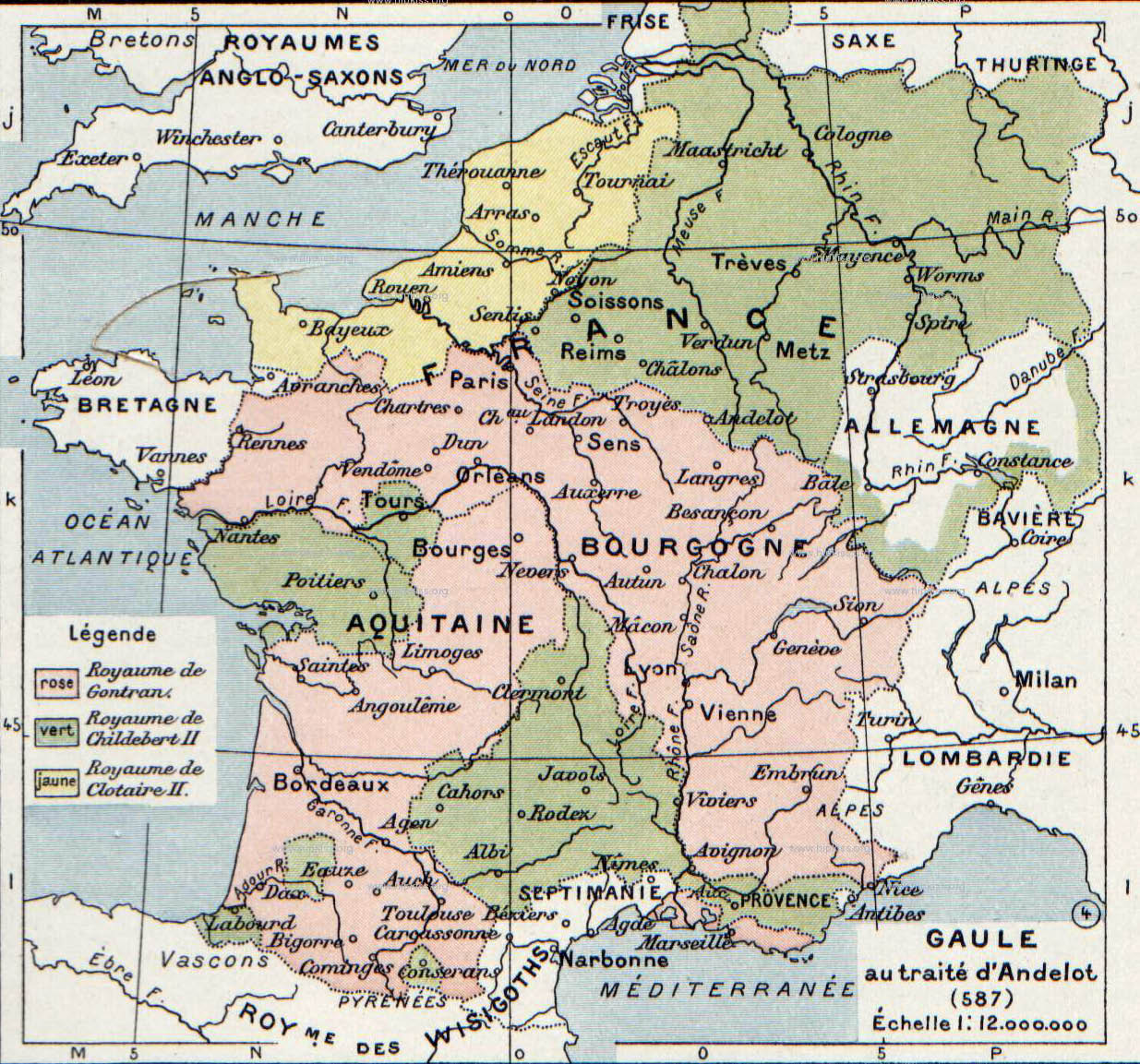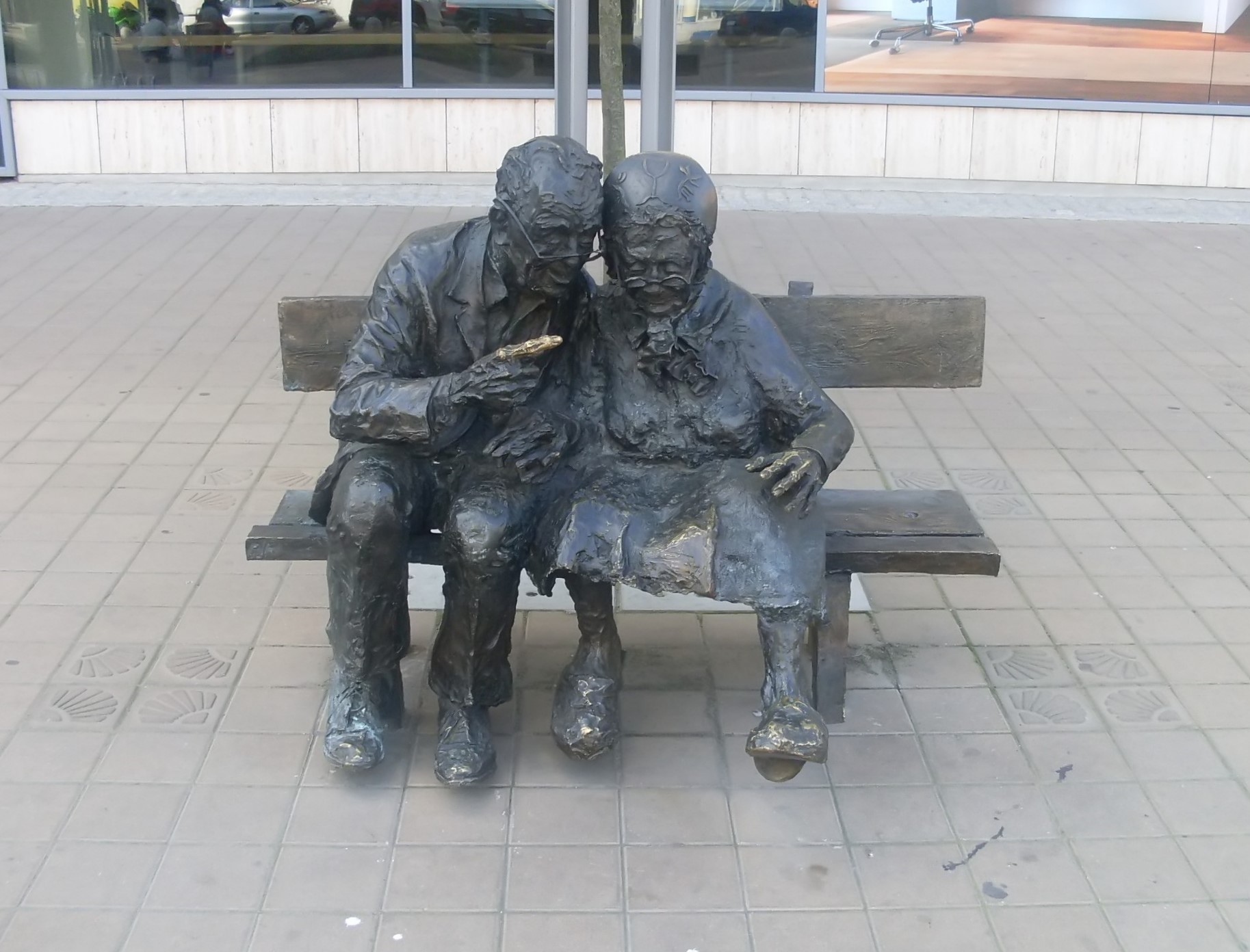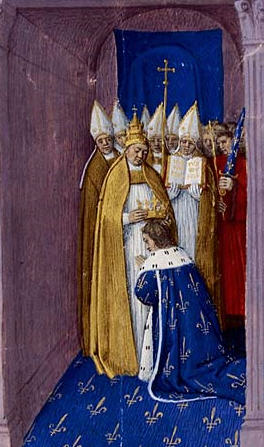|
Clothar II
Chlothar II, sometimes called "the Young" ( French: le Jeune), (May/June 584 – 18 October 629) was king of the Franks, ruling Neustria (584–629), Burgundy (613–629) and Austrasia (613–623). The son of Chilperic I and his third wife, Fredegund, he started his reign as an infant under the regency of his mother, who was in an uneasy alliance with Chlothar's uncle King Guntram of Burgundy, who died in 592. Chlothar took power upon the death of his mother in 597; though rich, his realm was one of the smallest portions of Francia. He continued his mother's feud with Queen Brunhilda with equal viciousness and bloodshed, finally achieving her execution by dismemberment in 613, after winning the battle that enabled Chlothar to unite Francia under his rule. Like his father, he built up his territories by seizing lands after the deaths of other kings. His reign was long by contemporary standards, but saw the continuing erosion of royal power to the French nobility and the church ag ... [...More Info...] [...Related Items...] OR: [Wikipedia] [Google] [Baidu] |
Chilperic I
Chilperic I ( 539 – September 584) was the king of Neustria (or Soissons) from 561 to his death. He was one of the sons of the Franks, Frankish king Clotaire I and Queen Aregund. Life Immediately after the death of his father in 561, he endeavoured to take possession of the whole kingdom, seized the treasure amassed in the royal town of Berny-Rivière, Berny and entered Paris. His brothers, however, compelled him to divide the kingdom with them, and Soissons, together with Amiens, Arras, France, Arras, Cambrai, Thérouanne, Tournai and Boulogne-sur-Mer, Boulogne fell to Chilperic's share. His eldest brother Charibert I, Charibert received Paris, the second-eldest brother Guntram received Burgundians, Burgundy with its capital at Orléans, and Sigebert I, Sigebert received Austrasia. On the death of Charibert in 567, Chilperic's estates were augmented when the brothers divided Charibert's kingdom among themselves and agreed to share Paris and the territory around it. ... [...More Info...] [...Related Items...] OR: [Wikipedia] [Google] [Baidu] |
Dismemberment
Dismemberment is the act of completely disconnecting and/or removing the limbs, skin, and/or organs from a living or dead being. It has been practiced upon human beings as a form of capital punishment, especially in connection with regicide, but can occur as a result of a traumatic accident, or in connection with murder, suicide, or cannibalism. As opposed to surgical amputation of limbs, dismemberment is often fatal. In criminology, a distinction is made between offensive dismemberment, in which dismemberment is the primary objective of the dismemberer, and defensive dismemberment, in which the motivation is to destroy evidence. In 2019, American psychiatrists and medical professionals Michael H. Stone, Gary Brucato, and Ann Burgess proposed formal criteria by which "dismemberment" might be systematically distinguished from the act of mutilation, as these terms are commonly used interchangeably. They suggested that dismemberment involves "the entire removal, by any ... [...More Info...] [...Related Items...] OR: [Wikipedia] [Google] [Baidu] |
Aquitaine
Aquitaine (, ; ; ; ; Poitevin-Saintongeais: ''Aguiéne''), archaic Guyenne or Guienne (), is a historical region of southwestern France and a former Regions of France, administrative region. Since 1 January 2016 it has been part of the administrative region of Nouvelle-Aquitaine. It is situated in the southwest corner of metropolitan France, along the Atlantic Ocean and the Pyrenees mountain range on the border with Spain; for most of its Recorded history, written history Bordeaux has been a vital port and administrative centre. It is composed of the five Departments of France, departments of Dordogne, Lot-et-Garonne, Pyrénées-Atlantiques, Landes (department), Landes and Gironde. Gallia Aquitania was established by the Romans in ancient times and in the Middle Ages, Duchy of Aquitaine, Aquitaine was a kingdom and a duchy, whose boundaries fluctuated considerably. History Ancient history There are traces of human settlement by prehistoric peoples, especially in the Périgord, ... [...More Info...] [...Related Items...] OR: [Wikipedia] [Google] [Baidu] |
Orléans
Orléans (,"Orleans" (US) and ; ) is a city in north-central France, about 120 kilometres (74 miles) southwest of Paris. It is the prefecture of the Departments of France, department of Loiret and of the Regions of France, region of Centre-Val de Loire. Orléans is located on the river Loire nestled in the heart of the Loire Valley, classified as a Loire Valley, World Heritage Site, where the river curves south towards the Massif Central. In 2020, the city had 117,026 inhabitants within its municipal boundaries. Orléans is the center of Orléans Métropole that has a population of 290,346. The larger Functional area (France), metropolitan area has a population of 454,208, the 20th largest in France. ... [...More Info...] [...Related Items...] OR: [Wikipedia] [Google] [Baidu] |
Paris
Paris () is the Capital city, capital and List of communes in France with over 20,000 inhabitants, largest city of France. With an estimated population of 2,048,472 residents in January 2025 in an area of more than , Paris is the List of cities in the European Union by population within city limits, fourth-most populous city in the European Union and the List of cities proper by population density, 30th most densely populated city in the world in 2022. Since the 17th century, Paris has been one of the world's major centres of finance, diplomacy, commerce, culture, Fashion capital, fashion, and gastronomy. Because of its leading role in the French art, arts and Science and technology in France, sciences and its early adoption of extensive street lighting, Paris became known as the City of Light in the 19th century. The City of Paris is the centre of the Île-de-France region, or Paris Region, with an official estimated population of 12,271,794 inhabitants in January 2023, or ... [...More Info...] [...Related Items...] OR: [Wikipedia] [Google] [Baidu] |
Soissons
Soissons () is a commune in the northern French department of Aisne, in the region of Hauts-de-France. Located on the river Aisne, about northeast of Paris, it is one of the most ancient towns of France, and is probably the ancient capital of the Suessiones. Soissons is also the see of an ancient Roman Catholic diocese, whose establishment dates from about 300, and it was the location of a number of church synods called " Council of Soissons". History Soissons enters written history under its Celtic name, later borrowed into Latin, Noviodunum, meaning "new hillfort", which was the capital of the Suessiones. At Roman contact, it was a town of the Suessiones, mentioned by Julius Caesar (''B. G.'' ii. 12). Caesar (''B.C.'' 57), after leaving the Axona (modern Aisne), entered the territory of the Suessiones, and making one day's long march, reached Noviodunum, which was surrounded by a high wall and a broad ditch. The place surrendered to Caesar. From 457 to 486, under ... [...More Info...] [...Related Items...] OR: [Wikipedia] [Google] [Baidu] |
Reims
Reims ( ; ; also spelled Rheims in English) is the most populous city in the French Departments of France, department of Marne (department), Marne, and the List of communes in France with over 20,000 inhabitants, 12th most populous city in France. The city lies northeast of Paris on the Vesle river, a tributary of the Aisne (river), Aisne. Founded by the Gauls, Reims became a major city in the Roman Empire. Reims later played a prominent ceremonial role in history of France, French monarchical history as the traditional site of the coronation of the kings of France. The royal anointing was performed at the Cathedral of Reims, which housed the Holy Ampulla of chrism allegedly brought by a white dove at the baptism of Frankish king Clovis I in 496. For this reason, Reims is often referred to in French as ("the Coronation City"). Reims is recognized for the diversity of its heritage, ranging from Romanesque architecture, Romanesque to Art Deco, Art-déco. Reims Cathedral, the ad ... [...More Info...] [...Related Items...] OR: [Wikipedia] [Google] [Baidu] |
Clovis I
Clovis (; reconstructed Old Frankish, Frankish: ; – 27 November 511) was the first List of Frankish kings, king of the Franks to unite all of the Franks under one ruler, changing the form of leadership from a group of petty kings to rule by a single king, and ensuring that the kingship was passed down to his heirs. He is considered to have been the founder of the Merovingian dynasty, which ruled the Frankish kingdom for the next two centuries. Clovis is important in the historiography of France as "the first king of what would become France." Clovis succeeded his father, Childeric I, as a king of the Salian Franks in 481, and eventually came to rule an area extending from what is now the southern Netherlands to northern France, corresponding in Roman terms to Gallia Belgica (northern Gaul). At the Battle of Soissons (486), he established his military dominance of the Domain of Soissons, rump state of the fragmenting Western Roman Empire, which was then under the command of Sya ... [...More Info...] [...Related Items...] OR: [Wikipedia] [Google] [Baidu] |
Chlotar I
Chlothar I, sometime called "the Old" (French: le Vieux), (died December 561) also anglicised as Clotaire from the original French version, was a king of the Franks of the Merovingian dynasty and one of the four sons of Clovis I. With his eldest brother Theuderic (c. 485 – 533/34) being the son of Clovis I and his first wife, Chlothar followed his two elder brothers Chlodomer (495–524) and Childebert I (496–558) as third surviving son of Clovis I and his second wife Queen Clotilde, lastly followed by their sister Clotilde (500–531). The name 'Chlothar' means "glory". In 511, Clothar I and his three brothers Theuderic, Chlodomer and Childebert inherited their shares of their father's kingdom. Chlothar spent most of his life in a campaign to expand his territories at the expense of his relatives and neighbouring realms in all directions. His brothers avoided outright war by cooperating with Chlothar's attacks on neighbouring lands in concert or by invading lands when the ... [...More Info...] [...Related Items...] OR: [Wikipedia] [Google] [Baidu] |
Division Of Gaul - 587
Division may refer to: Mathematics *Division (mathematics), the inverse of multiplication *Division algorithm, a method for computing the result of mathematical division Military *Division (military), a formation typically consisting of 10,000 to 25,000 troops ** Divizion, a subunit in some militaries *Division (naval), a collection of warships Science *Cell division, the process in which biological cells multiply *Continental divide, the geographical term for separation between watersheds *Division (taxonomy), used differently in botany and zoology *Division (botany), a taxonomic rank for plants or fungi, equivalent to phylum in zoology *Division (horticulture), a method of vegetative plant propagation, or the plants created by using this method * Division, a medical/surgical operation involving cutting and separation, see ICD-10 Procedure Coding System Technology *Beam compass, a compass with a beam and sliding sockets for drawing and dividing circles larger than those made by ... [...More Info...] [...Related Items...] OR: [Wikipedia] [Google] [Baidu] |
Monogamy
Monogamy ( ) is a social relation, relationship of Dyad (sociology), two individuals in which they form a mutual and exclusive intimate Significant other, partnership. Having only one partner at any one time, whether for life or #Serial monogamy, serial monogamy, contrasts with various forms of non-monogamy (e.g., polygamy or polyamory). The term monogamy, derived from Greek language, Greek for “one marriage,” has multiple context-dependent meanings—genetic, sexual, social, and marital—each varying in interpretation across cultures and disciplines, making its definition complex and often debated. The term is typically used to describe the behavioral ecology and sexual selection of animal mating systems, referring to the state of having only one Mating, mate at any one given time. In a human cultural context, monogamy typically refers to the custom of two individuals, regardless of orientation, committing to a sexually exclusive relationship. Monogamy in humans varies wi ... [...More Info...] [...Related Items...] OR: [Wikipedia] [Google] [Baidu] |
Pepin The Short
the Short (; ; ; – 24 September 768), was King of the Franks from 751 until his death in 768. He was the first Carolingian dynasty, Carolingian to become king. Pepin was the son of the Frankish prince Charles Martel and his wife Rotrude of Hesbaye, Rotrude. Pepin's upbringing was distinguished by the ecclesiastical education he had received from the Christian monasticism, Christian monks of the Basilica of Saint-Denis, Abbey Church of St. Denis, near Paris. Succeeding his father as the Mayor of the Palace in 741, Pepin reigned over Francia jointly with his elder brother, Carloman (mayor of the palace), Carloman. Pepin ruled in Neustria, Burgundy, and Provence, while his older brother Carloman established himself in Austrasia, Alemannia, and Thuringia. The brothers were active in suppressing revolts led by the Bavarians, Aquitanians, Saxons, and the Alemanni in the early years of their reign. In 743, they ended the by choosing Childeric III, who was to be the last Merovingian ... [...More Info...] [...Related Items...] OR: [Wikipedia] [Google] [Baidu] |











